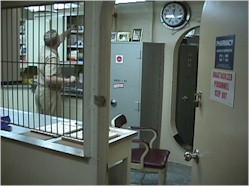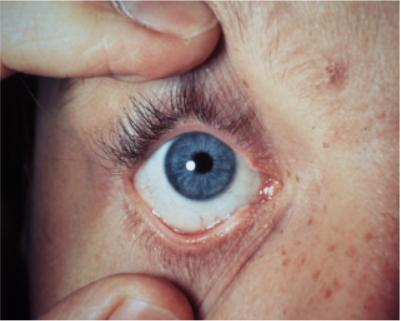Writing Prescriptions: Complete prescriptions in the following format.
PENICILLIN VK: 250mg 1 to 2 qid x 10 days.
Indications: Penicillin sensitive organisms such as streptococcus
Ampicillin: 250mg 1 to 2 qid X 10 days.
Indications: Respiratory, GI, Urinary, and ENT problems.
Amoxicillin: 250mg 1 to 2 tid X 10 days
Indications: Ear, Nose, Throat, Sinus, or Urinary Tract Infection.
Dicloxicillin: 250mg 1 to 2 qid X 10 days
Indications: Skin or soft tissue infections.
Erythromycin: 250mg 1 to 2 qid X 10 days
Indications: Ear, Nose, Throat, Respiratory, Skin, and Urogenital Infection.
Septra or Bactrim (Sulfamethoxazole and Trimethorpim) D.S.
1 bid X 10 days
Indications: Acute Otitis Media, Bronchitis, Sinusitis, and GU Infections.
Precaution: Do not give to a patient allergic to Sulfa medication
Tetracycline: 250mg 1 to 2 qid X 10 days.
Indications: Acne, Bronchitis, NGU infections.
Doxycycline: 100mg 1 bid X 10 days
Indications: Acne, Bronchitis. NGU infections.
Velosef (Cephradine): 250mg 1 to 2 qid X 10 days
Indications: Otitis Media, Respiratory, Urinary, Skin, and Soft Tissue infections.
OPTHALMIC (EYES) MEDICATIONS
Sodium Sulfacetamide (Sulamyd): 2 drops every 6 hours
Indications: Conjunctivitis PRECAUTION: If allergic to sulfa drugs
Gentamicin (Garamycin): 2 drops every 4 hours
Indications: Conjuctivitis
Erythromycin Opthalmic Ointment
(Ilotycin): apply 3 to 4 X daily
Indications: Conjuctivitis
ANTITUSSIVE
NOTE: Suppresses the response of the cough center. Should be used with caution in respiratory conditions like pneumonia, in which thick secretions are present, because this drug may impair mobilization of secretions.
Robitussin DM
(Dextromethorphan in
Guaifenesin)
2 teaspoons (10ml) every 6 hours
Indications: Non-productive Cough
ANALGESICS-ANTIPYRETICS
(Pain-Fever)
Tylenol and Tylenol ES (Acetaminophen)
2 PO every 4 hours or if ES 2 PO every 6 hours
Indications: Pain, Fever, Headache.
Aspirin (Acetylsalicyclic acid): 325mg 2 tabs every 4 hours
Ecotrin: Enteric coated ASA (not digested in stomach)
Ascriptin: ASA with an antacid
Indications: Pain, Fever, Headache, Inflammation of Joints.
ANALGESICS & ANTI-INFLAMMATORY
NOTE: Non-Steroidal anti-inflammatory drugs (NSAIDS) should be used with caution in patients with a history of ulcer or GI problems.
Motrin, Advil (Ibuprofen) 400-600mg qid or 800mg tid with food
Indications: Pain, Fever, Inflammation.
(Use Motrin prior to using NSAIDS)
Naprosyn (Naproxen) 500mg initially, then 250mg every 8 hours
Indications: Inflammation, Arthritis.
Tolectin DS
(Tolmetin) 400mg tid or qid
Indications: Inflammation or Arthritis.
BRONCHODILATORS
Proventil, Ventolin Inhalers
(Albuterol) or
Alupent Inhalers (Metaproterenol) 2 to 3 puffs every 4-6 hours
Indications: Asthma, Chronic Bronchitis, Emphysema.
OTIC-(EAR) MEDICATIONS
Cortisporin Otic Sunspension (mixture of hydrocortisone, Neomycin, and
Polymyxin)
4 to 5 drops into the infected ear every 4 to 6 hours
Indications: Infection and inflammation of external otitis.
Debrox: 5 to 10 drops in ear canal 2 times a day for 2 to 3 days then irrigate the ear.
Indication: Cerumen (ear wax) removal.
PRECAUTION: Do not use if ear drum is perforated.
ANTHISTAMINES
NOTE: These medications cause drowsiness, associated with dizziness, paradoxical excitement and hypotension.
Benadryl (Diphenhydramine) 25 to 50 mg TID to QID
50mg IM (for anaphylaxis)
Indications: Allergic Rhinitis, urticaria, pruritis, and Anaphylaxis.
Atarax (Hydroxyzine) 10 to 25mg tid to qid
Indications: Urticaria, Allergic Pruritis, Anxiety.
CTM, Chlortrimeton
(Chlorpheniramine Maleate) 4mg qid or 8mg bid
Indications: Allergic Rhinitis, Allergic Conjuctivitis, Pruritis.
Seldane (Terfenadine) 60mg 1 to 2 daily
Indications: Allergic Rhinitis, Pruritis.
Note: Least sedating, less drowsiness.
ANTIHISTAMINE AND DECONGESTANT
Actifed (Tripolodine and Psuedoephedrine) 1 tab every 6-8 hours
Indications: Allergic Rhinorrhea and Congestion.
Dimetapp
(Dexbrompheneramine) 1 tab bid
Indications: Allergic Rhinorrhea and Congestion
DECONGESTANTS
Sudafed (Psuedoephedrine) 30mg or 60mg tabs: 60mg every 6 hours
Indications: Nasal Congestion and Eustachian Tube Dysfunction.
Entex LA, Duravent (Phenylpropanolamine Guaifenesin) 1 cap bid
Indications: Nasal Congestion, Eustachian Tube Dysfunction.
EXPECTORANTS
NOTE: These medications increase respiratory tract fluid by decreasing the stickiness and thickness of the secretions, making their removal easier. They should be taken with a glass of water to help loosen the mucous secretions in the lungs.
Robitussen (Guaifenesin) syrup: 2 teaspoons (10ml) every 4 hours
Indications: Non-productive cough.
Humibid LA (Guaifenesin) 1 to 2 tabs every 12 hours
Indications: Dry, non-productive cough, and related conditions such as sinusitis, bronchitis, and asthma, when complicated by sticky mucous and congestion.
MUSCLE RELAXENTS
Flexeril
(Cyclobenzaprine) 10mg tid
Indications: Muscle Spasm.
Parafon Forte DSC (Chlorozoxazone) 1 tab qid
Indications: Muscle Spasm.
ANTI-DIARRHEAL DRUGS
Kaopectate (kaolin and Pectin) 2 to 4 tablespoons (60 to 120 ml), or two tabs after each loose or watery bowel movement.>
Indications: Diarrhea
Imodium (Loperamide) 2 caps initially, then I cap after each
unformed stool. (limit: 8 caps daily)
Indications: Diarrhea
Note: Do not use if diarrhea is due to poisoning or a bacterial infection that enters the intestinal wall, because the loss of the intestinal contents (diarrhea) is a protective mechanism.
LAXATIVES
Milk of Magnesia (MOM) 1 to 2 tablespoons (30 to 60ml) orally h.s.
Indications: Constipation
Metamucil
(Psyllium Hydrophilic Mucilloid) 1 teaspoon in 8oz
liquid 1-3 times daily
Indications: Constipation.
HEMORRHOIDAL PREPERATION
Anusol (Pramozine HCL) or Anusol HC (with Hydrocortisone)
Cream, Ointment, and Suppositories: 2 to 3 times daily
Indications: Relief of pain and itching caused by hemorrhoids and
Anorectal irritation.
ANTACID
Maalox (Aluminum and Magnesium Hydroxide) or
Mylanta (with Simethicone for flatulence and gas)
2 to 3 teaspoons (10 to 15ml)or 2 tabs between meals and bedtime
Indications: Hyperactivity, and with Simethicone: Flatulence
Gaviscon (Aluminum Hydroxide, Magnesium) Chew 2 tabs followed by half glass of water: 4 times daily and bedtime
Indications: Acid indigestion due to Acid Reflux.
ANTIEMETICS
Tigan (Trimethobenzamide) 250mg cap tid or qid, also as an IM inj.
Indications: Vomiting
Antivert, Bonine (Meclizine): chewable 25mg tabs
Indications and Dosage: For motion sickness: 1-2 tabs q 4-6 hours
For vertigo: 2 tabs bid
Dramamine
(Dimenhydramide) 50mg: 1-2 chewable tabs q 4-6 hours
Indications: Motion Sickness, Antiemetic
Note: Limit 8 tabs daily
TOPICAL ANTIFUNGAL MEDICATIONS
Lotrimin, Mycelex, (Clotrimazole) Cream:
Apply thinly and massage into affected area and surrounding areas every morning and evening for 1 to 4 weeks.
Monistat derm Cream
(Miconazole): Apply bid for 2 to 4 weeks
Spectazole Cream (Econozole): Apply bid
Tinactin, Pitrex Solutions (Tolnaftate): Apply bid
Itch Away, Desenex Powder
(Undecylenic Acid): Apply to feet PRN
Indication: Fungal Infections
CORTICOSTEROIDS
Note: These medications are used to reduce skin inflammation and pruritis.
Hydrocortisone Cream: .5 and 1% strengths, 30gm tube, apply 2-4 times daily.
Indications: Inflammatory dermatitis on face, groin, armpits, and for sebborrheic dermatits.
Westcort (Hydrocortisone Volerate) Cream or Ointment
.2%, 15gm tube, apply 2 to 4 times daily
Indications: Inflammatory Skin Problems (Dermatitis)
Note: More potent than hydrocortisone cream. Avoid or limit use on face.
Lidex (Flucinonide) Cream, Ointment, and Gel.
.05%, 15gm tube, apply 2 to 4 times daily
Indications: Inflammatory dermatitis not responsive to less potent drugs
ACNE PREPERATIONS
Benzogel, Desquam-X, Panoxyl (Benzoyl Peroxide) 5% to 10%
45mg tube, apply once daily for week then twice daily thereafter
Indication: Acne (Cleanse skin prior to use)
Retin-A (Tretinoin): Cream or Gel in .025, .05, and 1%
Apply once daily at bedtime. Wash face, wait 20-30 minutes before using. Squeeze a pea-sized dose out and dab it on forehead, chin, and cheeks, then spread it out. Keep away from nose, mouth, eyes.
Indications: Cystic Acne, flat warts on forehead. (Wash 2X daily)
ANTIPARASITIC MEDICATIONS
Kwell (Lindane): Cream and Shampoo
Note: Cream is the most reliable source for scabies.
Indications and use:
Crab Lice: Shampoo- Apply dry to hair and work thoroughly into the hair, wait 4 minutes, then add small amounts of water until a good lather forms. Rinse and dry. Nits should be combed out.
Scabies: Cream- Apply to dry skin and rub it from the neck down including the soles of the feet. Leave on for 8 to 12 hours and shower it off. One application is usually curative. Reapply to hands if they are washed. It is normal to itch for days or weeks after treatment. Further use is not only dangerous but will worsen by causing irritation. Kwell is safe if used as directed but is toxic when over used. DO NOT REFILL!!
OTHER TOPICAL PREPERATIONS
Calamine (Zinc Oxide): A cooling drying lotion. Apply 2-4 X daily
Indications: Pruritis (Itching).
Neutroderm Lotion, Alfa Keri lotion, Eucerin Cream.
Moisturizers and lubricants, apply PRN.
Indications: Dry Skin and Pruritis.
ANTIDANDRUFF-ANTISEBORRHIC SHAMPOO
Note: The shampoo must be allowed to remain on the scalp for 5 to 10 minutes before rinsing.
Selsun Shampoo (Selenium): Use 2 times a week for 2 weeks then once every 1 to 4 weeks.
Sebulex Shampoo (Sulfur & Salicyclic) Daily or every other day then 1 to 2 times weekly.
Sebutone Shampoo (Coal Tar, Sulfur, Salicyclic Acid) Every other day, then 1 to 2 times weekly.
HERPES MEDICATION
Zovirax (Acyclovir): Used for initial and recurrent herpes infection.
Capsules 200mg: Initial infection of genital herpes, 1 PO 5 times a day for 10 days.
Recurrent infection, 1 PO 5 times a day for 5 days.
Ointment 5%: Apply every 3 hours 6 times a day for 7 days. Use a Rubber glove to prevent autoinocculation of other body sites or infection of others. If recurrent, begin treatment as soon as signs and symptoms are noticed.





